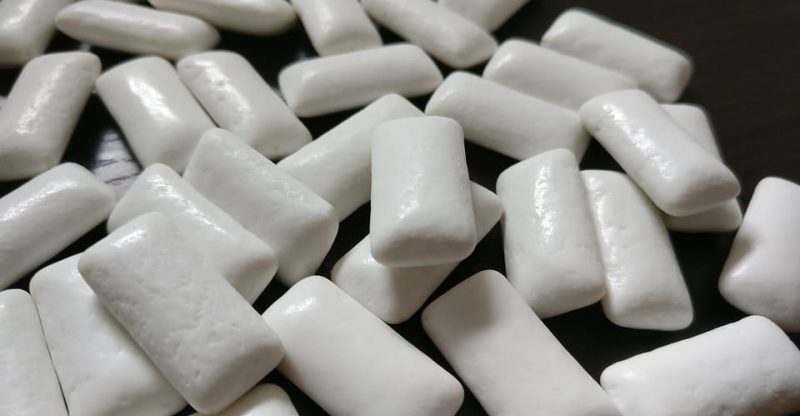What Is Glycerol Ester Of Wood Rosin (E445) In Food? Uses, Safety, Side Effects

Glycerol ester of wood rosin (GEWR), also known as ester gum, commonly used as a weighting agent or an alternative to brominated vegetable oil in citrus-flavored beverages, also functions as a softener in chewing gum. The European food additive number for it is E445.
Let’s dip into the navigation to know more of this ingredeint:
- What is glycerol ester of wood rosin?
- What is glycerol ester of rosin?
- Uses
- Approved Safety
- Possible Side Effects
- FAQs
- Conclusion
What is glycerol ester of wood rosin?
A complex ingredient mainly made of tri- and diglycerol esters of resin acids from wood rosin, and may also contain a small fraction of glycerol monoesters, free resin acids and neutrals (non-acidic compounds).
How is it made?
Glycerol ester of wood rosin is produced by the esterification from wood rosin and glycerol. There are two manufacturing processes for the purification of the wood rosin ester, depending on the purpose of uses, purified by steam stripping when used in chewing gum, or purified by counter-current steam distillation if used in adjusting the density of citrus oils for beverages.
What is wood rosin?
A solid resin extracted from aged pine stumps, it can be refined by removing volatile terpene fractions and impurities before the esterification with glycerol.
Components
It consists of approx. 90% resin acids (mainly of abietic acid) and 10% neutrals (non-acidic compounds).
Natural source
Wood rosin can be either sourced from Pinus palustris (longleaf pine) and Pinus Elliottii (slash pine) stumps. It is different with gum rosin, which is an exudate of living pine trees, has a similar component with wood gum; also different with tall oil rosin, which is a by-product of kraft (paper) pulp processing.
What is glycerol ester of rosin?
It is the general name of various rosins esterified with glycerol, e.g. glycerol ester of gum rosin, glycerol ester of tall oil rosin, glycerol ester of partially hydrogenated gum or wood rosin and so on. They are all approved safe by the FDA as a food additive.
Specification
| Other Names |
|
| CAS Number | 8050-30-4 |
| Chemical formula | Variable |
| Molecular Weight | Variable |
| Melting Point | 62–87 °C |
Structure
NA
Properties
Appearance
A hard, yellow to pale amber-coloured solid with low odor and taste.
Acid number
3 to 9
Solubility
Insoluble in water, oil-soluble and dissolved in acetone.
What is it used for?
Two main food uses
Food grade ester gum can be used as a chewing gum base component and an emulsifier or stabilizer/density adjustment agent for flavouring oils in beverages. Sometimes, its name may be shortened as glycerol ester of rosin in the ingredient list.
Brominated vegetable oil replacement
Ester gum can be a substitute for brominated vegetable oil, which is used to improve the stability of certain drinks by preventing other ingredients from separating.
Is glycerol ester of wood rosin safe to eat?
Yes, its safety when used as a food additive has been approved by the U.S. Food and Drug Administration (FDA), European Food Safety Authority (EFSA), Joint FAO/WHO Expert Committee on Food Additives (JECFA), as well as other authorities.
FDA
Glycerol ester of wood rosin is permitted for direct addition to food for human consumption and may be safely used in beverage for adjusting the density of citrus oils with the maximum amount 1.0 g/kg (1). Also, it can be safely used in the manufacture of chewing gum as a base component or a plasticizing agent. (2)
EFSA
Ester gum (E445) is listed in Commission Regulation (EU) No 231/2012 as an authorised food additive and categorized as “additives other than colours and sweeteners” (3)
Safety revaluation in 2018
EFSA re-evaluated the safety in 2018 for ester gum derived from approved sources Pinus palustris (longleaf pine) and Pinus elliottii (slash pine), also from the unauthorized sources Pinus Halepensis and Pinus brutia. The following are the conclusions (4):
ADI
The current acceptable daily intake (ADI) of 12.5 mg/kg body weight (bw) per day is temporary for Pinus palustris (longleaf pine) and Pinus elliottii (slash pine) due to the overall toxicity database and the absence of reproductive and developmental toxicity data.
Safety assessment
A safety of ester gum originating from Pinus Halepensis and Pinus brutia could not be assessed due to the unknown fractions of glycerol monoesters, free resin acids and neutrals, which are mainly related to toxicological testing.
Authorised uses and levels
The following foods may contain it with maximum levels ranging from 50 to 320 mg/kg (5):
- Entire fresh fruit and vegetables
- Confectionery including breath freshening microsweets
- Flavoured cloudy drinks
- Cloudy spirit drinks
UK Food Standards Agency
Categorized in “Others” (6)
Food Standards Australia New Zealand
In Australia and New Zealand with the code number 445. (7)
JECFA
Functional class: Food additives: adjuvant, bulking agent, chewing gum base compound, emulsifier, emulsifying salt, stabilizer. (8)
Acceptable daily intake: ADI of 12.5mg/kg was reset in 2013. (9)
What are the possible side effects?
It is common that sometimes consumers have health concerns if glycerol ester of wood rosin is bad for our health and what are the dangers. It is generally considered safe but no studies of chronic toxicity, carcinogenicity, reproductive and developmental toxicity are available at the moment mentioned by EFSA.
Allergy
Wood rosin is a skin sensitiser but no allergic reactions to food containing GEWR have been found.
Frequently asked questions
Is it natural?
No, it is made from chemical synthesis. The raw material wood rosin is a natural resin derives from P. palustris and P. elliottii. Glycerol used in the production of ester gum is from the plant source although glycerol can also be obtained from animal sources.
Is it vegan?
Yes, it is vegan if the raw material glycerol is from plant sources. So that the manufacturing process without the use of animal matter or products derived from animal origin. So it is vegan and suitable to add in the diet of vegetarians.
Is it Halal?
Yes, it is generally recognised as halal as it is permitted under the Islamic Law and fulfill the conditions of Halal. And we can find some manufacturers certificated with MUI halal.
Is it Kosher?
Yes, it is kosher pareve. E445 has met all the “kashruth” requirements and can be certified as kosher.
Is it gluten free?
Yes, it is typically gluten-free and people with celiacs can eat it. It is an ingredient commonly found in both gluten-free and gluten-containing food labels. The manufacturing process complies with the FDA’s definition of gluten free, that it does not contain wheat, rye, barley, or crossbreeds of these grains.
Conclusion
Now you may have a good knowledge of the food additive – glycerol ester of wood rosin (E445), from its production, uses, approved safety, possible side effects and some FAQs such as is it vegan, gluten free, synthetic or natural.
What kinds of food packaging have you found this ingredient in? Let me know in the comments.



Ester of wood resin is in usiningredients listed on 7-Elevens electrolyte hydration beverage called replenish zero it doesn’t State how much is in it
I found Ester gum in Gatorade Zero however it does not list quantity used. It also contains gum Arabic.
I found it in Gatorade. It doesn’t list the quantity.
Gatorade. Why is this in our food and drink and there have been no tests for long term side effects? As well…food dyes, why do we need in our food and drinks? I do not need food dyes..or chemical dyes to word that better. Food derived dyes from like beets would be fine.
Oasis citrus punch
Nature’s Twist strawberry lemonade.
it is in mountain dew spark flavor, so strange!
Red Bull The Yellow Edition Tropical Energy Drink. It is the tenth ingredient on the list. The label does not say how much is actually in it.
I found it listed in lucozade zero pink lemonade and lots of other stuff I don’t like the look of I don’t think I will buy it any more
I found it on the back label of Days Big Blue Soda and wondered what it was.
Its also in Thomas Henry Spicy Ginger 200 ml
It is SHINE WATER.
NO IDEAL HOW MUCH.
I found it in Mirinda Orange, The moment I have swallowed it i got a mild headache.
I found Glycerol Ester Of Rosin in Mtn Dew Trashed Apple Soda.
First- thank you for the information on this website! I’m more interested in the mechanics of what/why some things are added to the food we consume. From what I could surmise from the information provided, glycerol ester of rosin is used to suspend the citrus oils in my beverage, Gatorade Rapid Hydration. Without it all the citrus oils would float to the top of the water and not remain homogeneous.
Found in peach mango body armor lyte. Btw rlly good flavor, def one of my favorites. Definitely a 10/10 if you like peach and mango. It’s also only 20cal.